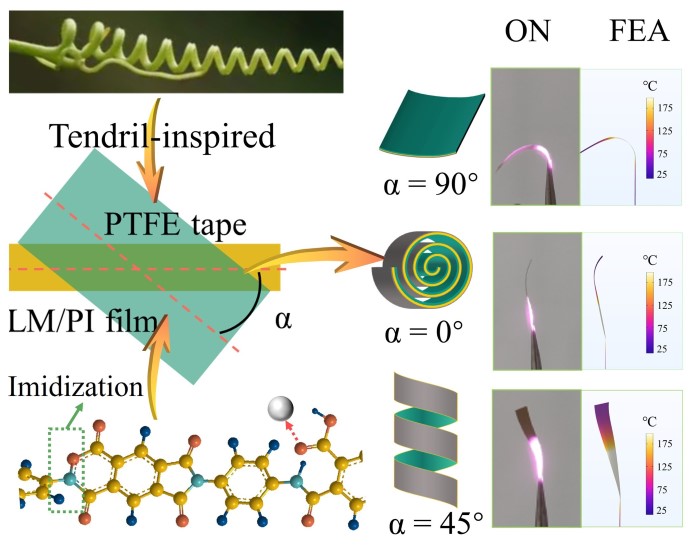A research team led by Prof. TIAN Xingyou and Prof. ZHANG Xian from the Hefei Institutes of Physical Science (HFIPS) of the Chinese Academy of Science (CAS) have utilized liquid metal to construct Liquid metal/Polyimide/Polytetrafluoroethylene (LM/PI/PTFE) programmable photothermal actuators based on asymmetric thermal expansion.
The study was published in Advanced Functional Materials as front cover.
"We were inspired by the way a plant's tip-sensitive region contracts on one side to form tendrils," said Dr. LI Xiaofei, first author of the paper, "The tendril-like actuator has customizable initial morphology."
Liquid metals, as emerging flexible photothermal materials that toughen without reinforcing polymers, are replacing traditional photothermal materials to prepare photothermal actuators. It is critical to enrich the action of liquid metal photothermal actuators and transform into robotic motion.
In this research, scientists have built a photothermal actuator using liquid metal/ polyimide (LM/PI) film and PTFE tape that mimics plants' ability to search for sunlight. They used LM/PI film as a support and photothermal layer, while PTFE tape acted as protoplasm that can contract and bend.
"When you assemble the PTFE tape to the LM/PI film from different angles, it curls like tendrils and you can obtain various shapes, which is why we refer to it as programmable." said LI Xiaofei.
The resulting actuator exhibited large deformation, rapid response, excellent stability, and high load-bearing capacity. It will promote the research and practical application in flexible robots, smart devices and bionic systems.
Furthermore, the researchers modeled the actuator and accurately predicted the bending morphology by finite element analysis. Based on the programmability of the initial morphology and the model prediction, the researchers successfully designed robots with crawling, rolling, swimming, grasping, and handling.
This new actuator paves the way for further development of photothermal actuators in bionic systems and robotics, according to the team.








